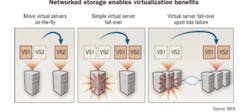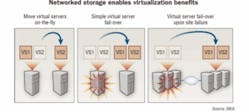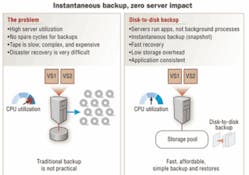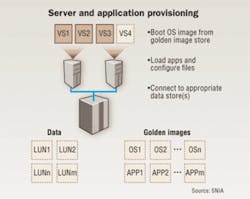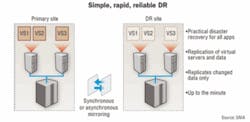by David Dale
iSCSI SANs provide a solid foundation for virtual servers.
Server virtualization is one of the hottest trends to emerge in the computer industry over the past few years, at both ends of the server spectrum—from mainframes to high-volume x86-based servers.
This article focuses on the volume server sector, where analysts estimate that 7% to 10% of x86 servers havealready been virtualized, and the rate of adoption islikely to accelerate when Microsoft enters the market later in the year. We'll briefly discuss the benefits of virtual server environments, describe the storage capabilities required to optimally support virtual servers, and explain how iSCSI-based SANs are providing those capabilities today.
Server proliferation problems
Judging from the rapid adoption of server virtualization, there must be a strong value proposition driving the trend. Quite simply, it's about reducing the costs of server proliferation.
Today more than ever, companies are dependent on the constant availa-bility of business applications and the rapidly growing amount of data theycreate. This drives increasingly stringent requirements for IT organizations as theystruggle to maintain and improve qualityof service (QoS) while operating with tight budgets, an already-lean IT staff, and limited time available toperform data-management functions.
Typical problem areas include:
Poor scalability and capacity utilization—Administrators face a frequent need to increase capacity toaccommodate rapid data growth, new applications, and increased I/O requirements—hence, server proliferation. But the resulting storage utilization rate is often as low as 30%, or less;
Physical infrastructure costs—Besides the physical hardware costs, server proliferation leads to significant floor space, power, and cooling expenses;
Increased administrative overhead—Server and application provisioning and maintenance become increasingly onerous;
Application availability issues—Server proliferationincreases the amount of planned downtime, and makes fast recovery from unplanned downtime increasingly challenging; and
Data availability and business continuity challenges—Mostly a consequence of direct-attached storage (DAS), timely backup and restore, and reliable and affordabledisaster recovery (DR), become increasingly difficult with server proliferation. Server virtualization can provide relief for all of these issues.
Virtual server benefits
Wikipedia defines server virtualization as "A method of partitioning a physical server into multiple servers that each have the appearance and capabilities of running on their own dedicated machine. Each virtual server can run its own full-fledged operating system, and each server can be independently rebooted."
In other words, you can consolidate n physical serversonto n virtual servers residing on a single machine. Typi-cally, in the x86 server space, we typically see between eight and twelve virtual servers deployed on a single physicalserver—although numbers up to 30 are not unusual, particularly when consolidating many older systems onto a new,and more powerful, x86 system.
Potential benefits include:
- Significant reduction in the number of servers required (10:1 is common), as well as associated savings in power, cooling, floor space, and administrative overhead;
- 60% to 80% server utilization rates (up from typical rates of <10%);
- Application provisioning time measured in seconds, not days;
- Response times for change requests measured in minutes; and
- Zero-downtime hardware maintenance.
Although networked storage is not arequirement for virtual server environments (DAS works in some cases), the majority of installations do deploy networked storage to meet the data availability and business continuance require-ments of their organization, and torealize the application availability and provisioning benefits enabled by their virtual server environment.
Storage demands
Clearly, if you consolidate the application workload and data that was formerlyrunning on, for example, 10 separate servers, there are some implications for the supporting storage infrastructure.
First, you need very reliable storage, because a storage failure can impact man more applications. This would typi-cally mean enterprise-class networked storage instead of internal (or direct-attached) storage [DAS].
The second issue is backup. In a consolidated virtualserver environment, you are likely to have 10 or more times the backup data to somehow accommodate in the backup window of a single physical server. So, backup has to be faster. Most IT shops solve this by offloading the backup processing overhead to storage by implementing array-based disk-to-disk backup and restore (snapshots) and archiving to tape from the offline snapshots.
The third issue is disaster recovery. A consolidated virtual server environment with networked storage enables relatively simple DR options via built-in virtual capabilities in the software and the storage devices.
Finally, to realize the rapid application provisioningcapabilities of virtual server environments and complementthem with rapid and flexible storage provisioning, you needthe built-in features usually associated with enterprise-levelnetworked storage arrays (see figure, page 23).
iSCSI for virtual servers
iSCSI-based IP SANs have become a popular consolidation solution for business-critical Windows environ-ments. Popularity has been driven not only by iSCSI's ability to provide affordable SAN storage, which is particu-larly well-matched to environments running on x86-based servers, but also by the fact that even entry-level iSCSI disk arrays typically include sophisticated data-managementcapabilities, such as point-in-time and remote copy, LUN cloning,iSCSI boot, and asynchronous mirroring. These enable IT organizations to improve data and application availability and recoverability, and reduce infrastructure and administrative costs.
Over the past year, there has been a significant uptake of iSCSI-based storage solutions in support of virtual server environments. The prerequisite, of course, was robust iSCSI support in virtual server software environments, including support for enterprise-level security options and integration with the virtual server storage administration environment. Thesecapabilities have all emerged over the past year,making iSCSI a viable choice for consolidating servers and providing storage services for virtual server software supporting business-critical applications.
Besides the feature set and operational capabilities, an important issue in these environments is that server and applicationadministrators can configure and maintain an iSCSI-based SAN. They all know how to configure TCP/IP ports andsecurity, and array management such as LUN masking istypically simple.
Configuration considerations
In an iSCSI-based SAN, host systems are provisioned withiSCSI initiators. Typically, software initiators are chosen. However, with virtual server environments—particularly when a single physical server is running a significant number of virtual server instances and CPU utilization goes above 70%—iSCSI host bus adapters (HBAs) or TCP/IP offload engine (TOE) cards are recommended. Also, a separate IP network or VLAN for storage traffic is recommended, configured with redundant connections supporting host multi-pathing.
LUN provisioning is straightforward: LUNs and virtualserver instances are provisioned, and LUNs are mapped toindividual virtual servers. Often, a secondary remote environment is set up, and array-based mirroring is configured to support data recovery and virtual server fail-over and recovery in the case of a failure at the primary site.
A variety of tools are available for data migration to the new virtual server environment. In addition, either host- or array-based snapshots integrated with the host environment can be used for fast backup and recovery of data and/or virtualservers. In addition, LUN cloning enables rapid provisioning of virtual servers.
The resulting environment provides improved storage and server utilization, a reduction in administrative overhead, fast backup and recovery, fail-over and continuous operation in the case of a disaster, rapid recovery in the case of application failure, and fast application provisioning for test and development and software upgrades. Advanced capabilities, such as thin provisioning, are now available on both the host virtual server and iSCSI arrays, enhancing utilization and recovery.
Combined with the affordability and relative simplicity of the infrastructure, iSCSI-based SANs are seen as an attractive option for server and storage consolidationprojects using virtual server software.
The figure "Instantaneous backup, zeroserver impact" (page 24) illustrates how the potential backup problem identifiedearlier is typically solved. The issue is how to minimize backup downtime andaccomplish greater backup processing ona fully utilized CPU. The answer is tooffload it to storage.
The use of array-based snapshot technology addresses these issues by allowingadministrators to effectively freeze the state of the data on disk at a particular point-in-time. Since this is not a "copy" per se—the operation is almost instantaneous, regardless of the amount ofdata involved—snapshots can eliminate the traditional concept of a "backup window." Snapshots can be kept on the primary array, or copied off to secondary storage (usually a lower-cost SATA-based system) for backup consolidation or tape archiving.
Data recovery is also extremely fast, since reverting to an earlier snapshot is effec-tively just a mount operation. Recovery from tape becomes unnecessary, saving untold operator hours and downtime.
The figure "Simple, rapid, reliable DR" (page 28) illustrates how the potentialdisaster-recovery issue identified earlieris usually addressed. The solution here,again, is to offload the problem to storage. Virtual server software does not nativelyprovide the capability to directly copy virtual servers to a remote location, so storage-based replication for both virtual servers and data is the usual solution.
The availability of native asynchronous mirroring options on iSCSI arrays provides a flexible,affordable way to perform remote mirroring of virtualserver instances and application data to other systems over an existing IP-based LAN, MAN, or WAN. Since iSCSI isa TCP/IP protocol, this solution is quick to deploy,relatively simple, and cost-effective
The figure "Server and application provisioning" (page 26) shows how the potential of fast application provisioning can be realized, again by leveraging capabilities that aresupported by many iSCSI arrays.
iSCSI boot (or "boot from SAN"), in combination with the availability of array-based LUN cloning, means that operating system and application environments can be rapidly provisioned. This approachaffords near-instantaneous image provisioning. In addition, the increasing availability of data deduplication solutionskeeps provisioning efficiency optimized.
Server, storage transformation
Many thousands of IT organizations have been able to reap the benefits of storage consolidation in Windows application environments using iSCSI-based SANs. In addition, we are now seeing significant uptake of iSCSI SANs for server consolidation projects using virtual servers, particularly in x86 server environments where the economics, skill sets, and application workloads are anexcellent match for iSCSI SANs.
By leveraging affordable IP SAN technologies and thesophisticated built-in features of iSCSI disk systems, companies can transform their server and storage infrastructure into a simple, powerful, consolidated environment that meets the increasing demands of their business applications.
This article originally appeared in the June issue of InfoStor, a PennWell Technology Group publication.—Eds.
David Dale is chairman of the SNIA IP Storage Forum and director of industry standards at NetApp.
